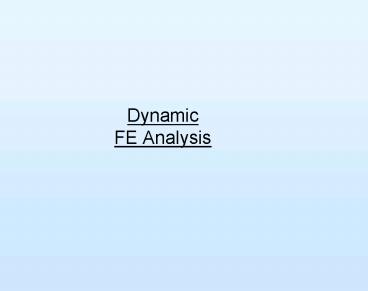Dynamic FE Analysis PowerPoint PPT Presentation
1 / 28
Title: Dynamic FE Analysis
1
Dynamic FE Analysis
2
Why?
- Modal analysis
- Determines a structures vibration
characteristics natural frequencies and mode
shapes
3
(No Transcript)
4
(No Transcript)
5
(No Transcript)
6
(No Transcript)
7
Why?
- Transient analysis
- Used when loading in time dependent e.g. slamming
loads, rotating machinery
8
Modal Analysis
If there is no damping and no applied loading,
the equation of motion in matrix form reduces to
where
Where
9
Modal Analysis
which may be solved using a finite element
approach to obtain the dry natural frequencies,
wi (where i 1, 2, 3), and principal mode
shapes. For the wet modes, where the
fluid-structure interaction is included, the
equation becomes
where
Where MS represents the ship displacement
MA is the ship added mass, representing
the inertia properties of the
surrounding water.
10
Modal Analysis
Note that
where
Where k is structural stiffness m
is structural mass
11
Geometry and Meshing
- Same considerations as a static analysis
- include details to sufficiently represent model
geometry - fine mesh required to resolve complex shapes
- Both Youngs Modulus and Density required
- Linear elements and material properties only.
Nonlinearities are ignored
where
12
Analysis Type
Analysis Type is modal Solution gt Analysis Type
gt New Analysis gt Modal
where
13
Analysis Options
Solution gt Analysis Type gt Analysis Options
where
14
Analysis Options
- Mode extraction options
- Block Lanczos generally recommended
- Number of nodes - specify number of nodes to be
extracted - Mode expansion options
- Expanding modes allows the user to view modes in
post processor usually expand same number as
extracted - Default settings are usually sufficient
where
15
Loading
Only displacement constraints are valid in modal
analysis If no displacement constraints rigid
body motions will be calculated (zero frequency)
where
16
Post Processing
Post Processor gt Results Summary
where
17
Post Processing
Read results for subset Post Processor gt Read
Results Then plot the deformed shape
where
18
Post Processing
Results may be animated Utility menu gt Plot
Ctrls gt Animate gt Mode Shape
where
19
Transient Analysis
A transient analysis is more involved than a
static or harmonic analysis. It requires a good
understanding of the dynamic behavior of a
structure. Therefore, a modal analysis of the
structure should be initially performed to
provide information about the structure's dynamic
behavior.
where
20
Transient Analysis
- The Full Method
- This is the easiest method to use.
- All types of non-linearities are allowed.
- It is however very CPU intensive to go this route
as full system matrices are used.
where
21
Transient Analysis
- The Reduced Method
- This method reduces the system matrices to only
consider the Master Degrees of Freedom (MDOFs). - Because of the reduced size of the matrices, the
calculations are much quicker. - However, this method handles only linear
problems.
where
22
Transient Analysis
- The Mode Superposition Method
- This method requires a preliminary modal
analysis, as factored mode shapes are summed to
calculate the structure's response. - It is the quickest of the three methods, but it
requires a good deal of understanding of the
problem at hand.
where
23
Load Time History
Time step, dt 1/20f Where f is the smallest
modal frequency to be captured
where
24
Transient Analysis Options
Analysis Type is modal Solution gt Analysis Type
gt New Analysis gt Modal
where
25
Transient Analysis Options
Option for method type
where
26
Transient Analysis Options
Define degrees of freedom for consideration Solut
ion gt Master DOFs gt User Selected gt Define
where
27
Define Loads Solve
Define time step Solution gt Load Step Opts gt
Time/Frequenc gt Time - Time Step .. Write Load
Step File Solution gt Load Step Opts gt Write LS
File Solve Solution gt Solve gt From LS Files
where
28
Post Processing
Timehist Postpro gt Results Summary Able to plot
results vs. frequency and time Note also able
to include damping term
where

